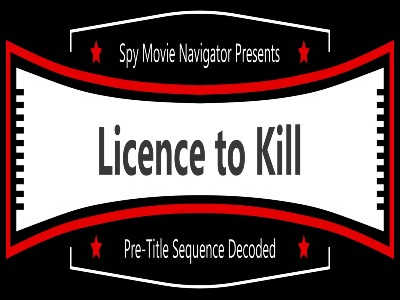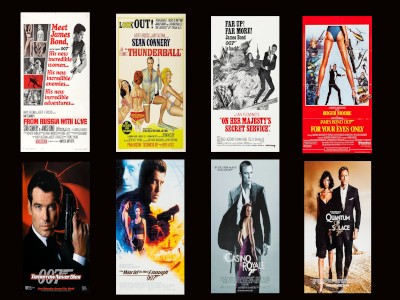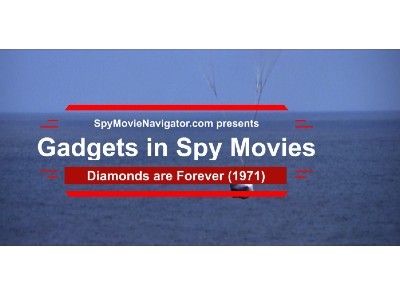HOW EVENTS IN THE REAL-WORLD AFFECT WHAT GOES INTO SPY FILMS – Part 2
This is Part 2 of our look into how events in the real-world affect what goes into spy movies.
Have you ever thought about how events in the real world and other movies could affect and work their way into some of our favorite spy movies? Well, think about it a minute because that’s what we are going to explore today on Spy Movie Navigator.
Hi, this is Dan Silvestri and Tom Pizzato at Spy Movie Navigator.com – the Worldwide Community of Spy Movie Fans – Spy Movie podcasts, videos, discussions and more
We’ll continue looking at some of the Bond films. Part 2 will start with Diamonds are Forever.
Diamonds Are Forever – 1971 Published by Ian Fleming in 1956 as his 4th James Bond novel, EON Productions made it into their 7th James Bond 007 movie, introduced in 1971. Here, Bond – Sean Connery comes back – infiltrates a diamond smuggling ring and prevents Blofeld and SPECTRE from developing a space-based laser weapon with the diamonds that could blow things up. Blofeld was going to sell it to the highest bidder, so Bond had to stop the plot.
- So, Ian Fleming writes Diamonds Are Forever only 9 years after a woman copywriter for an ad agency wrote “A Diamond is Forever” for a DeBeers ad campaign, in 1947 – and it’s been in DeBeers campaigns ever since! See a great online article on this in the New York Times by J. Courtney Sullivan, May 3, 2013.
- The Burton-Taylor diamond, like 69 carats, purchased in 1969 made world-wide news. That, combined with Jacqueline Kennedy’s jewelry (diamonds and emeralds ) in the early 1960s put diamonds on the mind of everyone. Coincidence or great timing by EON, the subject of diamonds was ripe for the 1971 launch of Diamonds Are Forever.
3 Days of the Condor – 1975. Intense movie. Influenced by Watergate (no trust of people in power) and the oil shortages prevalent in the mid-1970s.
Moonraker – 1979 – Moonraker, Fleming’s 3rd novel, was published in 1955. Rockets were just being developed after von Braun’s success with the Germans in World War II. The novel is about a rocket being developed and that will be tested by Drax’s organization, with support of the British government. By the time the movie was made by EON Productions in 1979, the writers had to change the story. It was 1979 and man had already been to the moon and back, the space shuttles were under development, a story about a missile test would not cut it. Trust me, the novel is a great read, and when you consider the times, it was very exciting. So, the first real-life incident to affect this movie was
- The story is changed completely, except keeping Hugo Drax as the main villain, because of the rapid development of rockets, manned space flight, the moon landings and the development of the shuttle (which first flew in 1981).
- Secondly, the novel plot is a great one but dated for the EON Productions 11th James Bond movie in 1979. EON had originally planned to film For Your Eyes Only after The Spy Who Loved Me (one of my all-time favorite Bond movies). But because of the development of the Shuttle in real life, and the popularity of two of the biggest science fiction films released in 1977, Star Wars (with a second planned for 1980) and Close Encounters of the Third Kind. So, EON Productions, once again being clever and watching the real world and what was successful and popular, moved Moonraker up ahead of For Your Eyes Only to take advantage of the popularity and success of science fiction movies, and actual NASA advancements in space technology.
- Also, the concept of a space station, used in Moonraker, was based on real-life as well – the Soviets had Salyut 1 space station in 1971, and the US had Skylab up in 1973.
Once again, real-life influences major elements of the spy film genre!
The Living Daylights – 1987 death to spies, Smyert shpionam. And the idea of a spy defecting, of course, is based on real stuff – spies defect in the real world. In fact, Nikolai Khokhlov was a Soviet spy who defected to the west in 1953 and brought with him all kinds of spy gadgets which we will talk about in a moment.
Licence to Kill – 1989
- The whole premise of the film is dealing with a drug lord from South America. In 1972, then President of the United States Richard Nixon said drug abuse was “public enemy number one/” In 1986, President Regan o the United States called for a “nationwide crusade against drugs.” So drugs infiltrating and affecting thousands of lives was definitely a popular topic during the decades surrounding the release of Licence to Kill.
- So Franz Sanchez, being a major drug dealer, would have garnered a lot of attention if the Department of the Drug Enforcement Administration knew of his whereabouts. So the DEA response to Sanchez being tracked to the United States would have warranted the response it got in the movie – and probably a whole lot more.
Mission: Impossible – 1996
Between Goldeneye (1995) and Tomorrow Never Dies (1997) comes the first in the series of Mission: Impossible movies based on the 1960s television show. So, 1996 was a great time to capitalize on the spy movie fans waiting for another Bond movie, and since Bourne Identity was not born until 2002.
The Mission: Impossible TV show, which I loved, certainly had an influence on the creation of the movie. Many fans of the TV series were looking forward to the first movie. While Phelps was the only character kept from the TV series, the mission was to be fresh, full of action and intrigue. The concept of a rogue agent trying to make things right was not new, but this mission was done with passion.
MacGyver-like gadgets, and to some degree sophisticated gadgets, masks and deception all came from the TV show. The original show was more like an O’Henry play, with surprise endings for the bad guys, and Martin Landau (who played Rollin Hand in the original TV series) said when interviewed after the first Mission, the original was not an action-adventure, it was more of a “mind game. The ideal mission was getting in and getting out without anyone ever knowing we were there.” ( quote from, Martin Landau Discusses ‘Mission: Impossible’ Movies (blog), MTV, October 29, 2009. The non-stop action is truly new to the movie.
So, we think the first film of the Mission: Impossible series was influenced by
- The TV show, for basic concepts, self-destructing mission messages, music, etc. and
- The timing, in between Bond films.
- The worldwide locations, like shooting in Prague, was definitely Bond–influenced, as were the opening scenes during the credits, giving glimpses into the action about to unfold.
Of course, the real Cold War spying – going after atomic data, and lists of spies – was a regular mission of spies. Even in 2015, the US CIA was concerned that China had stolen info on US federal employees that might expose the real names of our spies abroad. So, the basic concept of the mission in the first Mission: Impossible movie is very grounded in reality.
The Bourne Identity – 2002. 9/11 made the producers think that the script, with the CIA looking like the bad-guy, might be too sensitive for audiences in the aftermath of the attack on the World Trade Center and the Pentagon on September 11 2001. They actually filmed alternative opening and ending sequences, but when the original was tested with audiences, they seemed to accept it very well, so the alternative opening and closing scenes were relegated to the bonus section of the DVDs (See “Fifteen Things You Didn’t Know About the Bourne Franchise” by Josh Roush, July 29, 2016, online article.
Casino Royale – 2006 – certainly the popularity of Texas Hold’em worked its way into the film, instead of the as-written Chemins de fer/baccarat game in the Fleming novel. Also, the more realistic approach of The Bourne Identity movie may have influenced Casino Royale to more grounded in basics – although, for a reboot of the Bond franchise, one would think they would stick closely to the novel which, as the first novel, was very straight-forward, with few gadgets, and basic in execution.
Bond on Skis: George Lazenby, who was an avid skier, is the first James Bond in EON Productions films to take to skis, in On Her Majesty’s Secret Service (1969), with many of the scenes filmed in Murren, Switzerland – which we at SpyMovieNavigator have been too! It is about 5,000 feet below Schilthorn (Piz Gloria) where Blofeld’s “allergy research institute” was located in the film. In a night scene, Bond begins to ski down Piz Gloria, and of course is shot at, then pursued by Blofeld’s henchmen on skis. Even Blofeld joins the pursuit on skis. With flairs and machine guns, they pursue Bond – and of course they know the mountain better than Bond, so they are in hot pursuit. Great chase scene, with well-trained and skilled agents in pursuit on skis.
And in the 1977 Bond film, in the pre-title sequence of The Spy Who Loved Me, we have one of the best snow ski sequences in any spy movie film – in any film for that matter. He gets a message from MI6 saying they need him, while he is sleeping with a woman in an Austrian winter mountain chalet. So he leaves, with a red backpack on his back, and skis. She immediately radios her counterparts to say he is leaving, and we have another ski chase scene, pursuers shooting at him, and at one point, Bond turns around and shoots one of the foreign agents with his ski pole gun. Then he continues, eventually skiing off the mountain with thousands of feet beneath him – only to pop a parachute with the Union Jack to land safely. A great pre-title sequence that has become an iconic scene around the world! Reported filmed in Canada, the stunt man who did this, Rick Sylvester, did this in one take. They had to wait for the weather to be just right, and not too windy. Again, skiing and pursuit by trained assassins on skis.
In For Your Eyes Only, Bond is pursued by sharpshooter skiers and enemy agents on specially equipped motorcycles, with spiked wheels and guns, down the mountain and eventually into a lift heading to a ski jump. Of course, Bond must do the jump, as his pursuers wait at the bottom of the ski jump hill. The pursuit continues again on the special motorcycles chasing Bond on skis., which even includes skiing down a bobsled run.
In A View to a Kill, Bond does it all on snow – from skiing to snowmobiling to riding one of the runners from the snowmobile as a snowboard! Here pursued by a helicopter, snowmobiles, skiers – every well-trained assassin – but he finally escapes and to a British sub disguised as an iceberg. Cool. But he had a talented mob of agents, trained for winter pursuit, behind him all the way.
Of course, even The Living Daylights has a snow pursuit, as Bond and Kara Milovy escape using her cello case as a sled, and cello to steer, they are pursued by trained agents on snow.
SPECTRE has snow scenes as well. So what is happening here?
In real life, of course, there were and are specialty teams in various military branches throughout the world who are expert at traveling on skis, infiltrating locations on skis, and doing other espionage stuff that very much depends on how well trained they are on skiing and moving through heavy snow conditions.
For example, in WW-II, the U.S. did not have a mountain division in their military. Inspired by the Finnish mountaineer troops, Charles Mynot Dole – who was head of a ski patrol, an Olympic skier, a climber – began the U.S. military ski troops, brought into action just before Pearl Harbor. They trained at 13,000 feet in the Colorado mountains, at – 30 degrees Fahrenheit (-34.4 degrees Celsius) with 90 pounds of gear – just the men, packs and skis – pushed to the limits. This will turn out to be a true “mission impossible” in World War II as this became the 10th Mountain Division of the U.S. Army. They were engaged against the Japanese when Japan invaded two islands off Alaska – Attu, and Kiska. Landing in fog and snow, they were able to make the Japanese retreat but confused, our troops were shooting at each other and 18 were killed. They went back for more training, with mock battles, in sub-zero conditions.
They were called upon in 1944 in Italy, where the Allies were bogged down trying to take the Apennine mountains. The 5th Army could not advance towards Germany. Each ridge in the mountains had additional German defenses. The 10th Mountain Division assessed what was needed, decided they had to take Mount Belvedere and to do that had to take Riva Ridge first. 2,000 feet up, steep, 3 – 4 feet of snow. They climbed the unclimbable and took Riva Ridge, and the engineers erected an ingenious tramway to move wounded and supplies up and down the mountain. This is REAL stuff! The pursuing assaults were successful, and the path open to Germany thanks to this 10th Mountain Division – trained to battle in treacherous snow conditions. They prevailed at great cost for the campaign – with 975 killed, 3,871 wounded and 20 prisoners of war. But they prevailed.
- For more info, you can visit: 10thMtnDivAssoc. Org or LastRidge.com
In another World War II real-life adventure, the Germans controlled a heavy-water plant in Norway, and heavy-water was needed to make nuclear weapons. On February 16, 1943, Operation Gunnerside began. 6 Norwegian commandos were dropped by parachute to join the ‘Swallow’ team on the ground. After a few days of cross-country skiing, they joined the Swallow team. The final assault on the heavy-water plant was set for February 27/28 1943. The Germans controlled the plant and wanted to produce the heavy-water and ship it to Germany. The heavy water plant was protected by mines, lights and more due to an earlier failed raid. The Swallow team, with the 6 paratroopers, ford a winter river in a ravine and climbed a steep hill. They followed a railway track right to the plant – because a Norwegian agent inside the plant supplied a detailed layout of the plant as well as a schedule. This is very much like From Russia With Love, as Bond was to retrieve the consulate plans from Tania.
Except here, it is real life! The team entered the plant by a basement cable tunnel, set explosives and escaped. They left behind a Thompson sub-machine gun to make it look like British forces did it and not local resistance to avoid reprisals. It worked!
Desperate, the Germans loaded some heavy water on a ferry bound for Germany, and the Norwegian resistance sank the ferry and all the heavy water! Google: Gunnerside.
So the bottom line is, many of the scenes we have seen in spy movies, and above the Bond movies, have a basis in reality – people are indeed specially trained for these special operations, and so the specially trained personnel in the Bond movies for all the winter pursuits are believable. Some of the stunts are fantastic, but so were some of the real-life challenges that were overcome by the 10th Mountain Division and the Norwegian troops!
Gadgets: Lastly let’s look at gadgets. As we know, gadgets are prominent in the James Bond 007 movies by EON Production, as Q proves quite the inventor. They are also present in the Mission: Impossible series, with masks, high-tech devices like the climbing gloves, the camera glasses in Mission Impossible 1 and so on.
In the Ian Fleming books, gadgets were less prominent. In Casino Royale, the first James Bond 00 novel, there are some gadgets, but spectacular. Le Chiffre carries razors in various places, and one of the high tech gadgets was a cane that doubled as a gun – which really was how they tried to first kill Bond at the casino table. It goes on in other Fleming novels as well, with underwater equipment, the briefcase in “From Russia With Love” – which is different than what it contains in the movie. But they are there, but less obvious and less of a focus. There really was a Q Branch in MI6, and they came up with gadgets. It was operational at the time Fleming was writing and run by Charles Fraser-Smith, who Fleming knew.
Again, in this really cool book, “For Your Eyes Only – Ian Fleming + James Bond” by Ben Macintyre, he suggests that Fraser-Smith made things like a hairbrush that has a map and a saw, cameras hidden in cigarette lighters, invisible ink, magnetized matches that could act as a compass, and so on. So there was real stuff, and that real stuff influenced the movies and served as a basis of many extraordinary gadgets to come in the films.
We mentioned a defector spy from the Soviet Union who defected to the West, Nikolai Khokhlov. In the same book mentioned above, Macintyre suggests that when Khokhlov came over, he brought a lot of spy gadgets with him, including a miniature revolver that could fire toxic bullets, guns housed in cigarette lighters and lots more – for real!
Thanks for listening – we hope you enjoyed this podcast 0- if you did, please give SpyMovieNavigator a 5 star review on iTunes which helps us do more podcasts, and keep downloading our podcasts and checking our website for the latest on spy movies – we are SpyMovieNavigator.com – the Worldwide Community of Spy Movie Fans – Spy Movie podcasts, videos, discussions and more!




